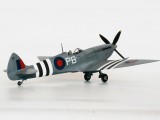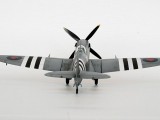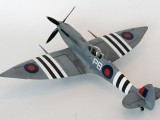VICKERS SUPERMARINE SPITFIRE HF.Mk.VIIc
Wing Commander Peter Mallan Brothers CBE, DSO, DFC, RAF
Spitfire HF Mk.VIIc S.N. MD188
August, 1944
Vickers Supermarine Spitfire HF Mk.VIIc, S/N MD188
MD188, an HF Mk.VIIc was the third-to-last MkVII Spitfire to be built, coming off the Eastleigh production line in the third week of May, 1944.
Equipped with a Merlin 64 engine it was initially delivered to No 33 Maintenance Unit and was subsequently issued to No 131 Squadron in mid June, just too late to have seen action on D-Day itself.
Its combat career as Wing Commander Pete Brothers' personal aircraft as part of the Culmhead Wing at RAF Colerne was brief, being sent to high altitude trials only three months later on October 9, 1944. Little else is known about its consequent use; however, MD188 was struck off charge on December 9, 1948 and in all likelihood was sold for scrap soon thereafter.
The Kit and my Build
The ICM 1/48 scale kit is a good basis to begin with, but there are several things that need to be done to make the kit a true Mk. VII. So let me begin, for the Spitfire boffins out there, with what I did do:
- Added the pressure bulkhead behind pilot's seat
- Filled the panel lines for the cockpit entry door
- Scribed the panel lines for the leading edge wing fuel tanks
- Left off the Oleo scissors.
And, what I didn't do:
- Change the glass behind the canopy
- Change the tail wheel
- The gasket on the side portion of the windshield
- Remove the pilot's headrest (forgot)
Aside from the foregoing this was a straightforward ICM Spitfire build. Care needs to be taken in assembling the front half of the fuselage but aside from that it's really not that much of a challenge. I built this one entirely out of the box – there was some clean up required on some of the parts but the usual problem areas such as wheels, prop blades and aileron sink marks weren't too bad in this particular kit.
I started the painting with the invasion stripes, when done I masked them and worked on the air-frame. I used Tamiya acrylic paints for the main colours, mixing the shades for the PRU Blue and Medium Sea Grey. I started with a base coat for each, then a darker shade applied to main traffic areas and a lighter shade to some panels to add depth. Finally I applied an overall coat of a highly thinned lighter shade to blend it all in. I was pleased with how it turned out. I am depicting the aircraft at a time when it had been operational for only about six weeks so I didn't feel it should look too beaten up but certainly used.
I made a couple of judgment calls on the specific markings as I had no reference photos of this aircraft. I based much of my assumption on a couple of photos of a signed model of MD188, figuring that if the man himself had signed the model than it must be close. To that end, I did apply Wing Commander pennants to both sides of the fuselage and I also applied the serial number decals in such a way as to simulate that they had been painted over with the invasion stripes. Finally, and without any evidence that they were there on the real aircraft, I decided to add 15 kill markings. I did this because I thought it plausible that they would have been there, and also to acknowledge that Brothers was a very accomplished fighter pilot and I wanted my model to reflect that.
After a gloss coat to prep for the decals and some light wash work, I sealed it all up with a final gloss coat before applying the flat coat. I felt the invasion stripes would be very matt, so I masked and flattened them first and then gave the entire model another couple of light coats. I was going for a satin sheen finish and I am happy with how it turned out. Lastly, I applied some pastel staining to show a little wear and tear (although only a few weeks old, MD188 would still have had to work hard the two months after D-Day as I presume there would have been a lot of sorties).













Nice, clean build, gotta love those stripes, they look good!
Great little model, Mark...nice photos, too. I like it.
This looks very much Spitfire in its shapes and this simple finish with just the right amount of weathering and sheen. Excellent job indeed.
Another very well finished model, with plenty of attention to detail. I like it, Mark.
Excellent build of a much underrated kit. You've done a beautiful satin finish here which is most attractive & brings out the best in Spitfire shapes.
Cheers,
Tony
Nothing looks like Spitfire, simply elegant!
Mark,
All I can say is that this is a gorgeous example of your excellent work.
beautifully done